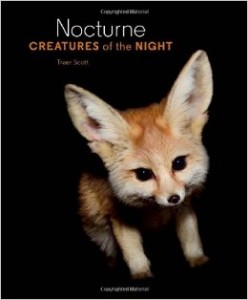A few weeks ago the Rogers’ family broke out into argument about nocturnal animals; specifically bats. Truthfully, I can’t remember the specifics of the argument, but the teacher in me went right to the book store. What information could I find that would be relevant and engaging to help us learn as a family? I found this book.
Why I Finished It:
Scott begins with a narrative about the experience of putting this informational text together. She explains how the idea for the book came together, why she chose photographs of the creatures, what she learned, and how it all came together. This introduction, brought me closer to the subject matter and helped me understand the author’s passion. Each animal addressed has a short, manageable amount of information with two to three beautiful photographs of the animal. Knowing how the photographs were taken drew me even further into the photograph.
Who I Would Give It To:
Any person, adult or child who is interested in animals. Admittedly, animals are not my go to topic, but I was captivated by the photographs and information.
Integration Ideas:
Author’s Purpose and Writing (Expository or Personal Narrative)
Traer Scott begins with an explanation of how this project, the book, came to fruition. Not only does this get students in to the book and help them read with a deeper sense of purpose for themselves, it will also help readers understand the author’s purpose for writing. What was her purpose before she began and how did the purpose evolve? Using the narrative, have students back up their purposes with facts from the author herself.
I would turn this into a writing assignment for the students. Scott began with a topic, moths, that was interesting to her. Have students list out subjects that they are passionate about. Scott explains that she began with moths, but slowly moved into the intriguing life of nocturnal animals. Have students choose one of their favorite topics from their own list and see if it spurs other ideas. This can easily turn into a personal narrative or expository piece, but also a research project.
Facts, Details, Main Idea of Nonfiction Text
When students read nonfiction, my main goal is for them to be able to find main facts and explain what the main idea is. This book is already splendidly chunked for students to learn and immerse themselves in information. After reading one page, any page, no need to go in order, have students discuss what they learned. (This is a great place to employ a Reading and Analyzing Nonfiction Frame). As a class, pull out three of the most important facts. In order for students to say it is one of the most important facts, they must use text evidence to defend their decision. I would probably use consensus for this activity. Have two students decide on their three most important facts, then they will join another partnership where the four students will discuss what they think are the three most important facts. As a group of four, they must decide which three facts are the most important. Then all groups of four will share together, until they all decide they have the top three. This rich conversation will help students understand the concept of finding the main idea and understand the text itself.
Once the facts have been decided upon, have the students find the main idea. I prefer to use “Get the Gist” to find the main idea for both fiction and nonfiction. After rereading the page to the students. The students must decide who or what the page is about. Then the students must say what is so important about the who or the what in ten words or less. This must be a complete sentence.
Author’s Website: http://www.traerscott.com/nocturne-creatures-of-the-night/
How have you used this book?







Leave a Reply